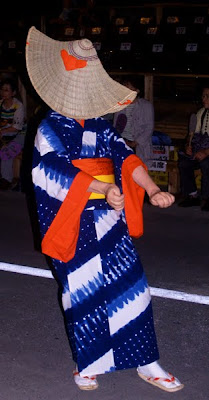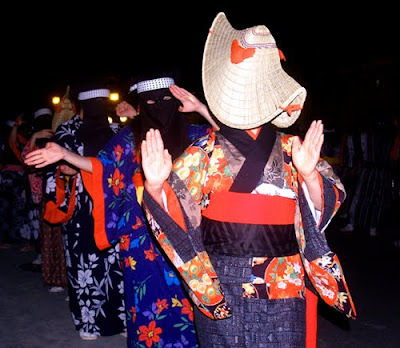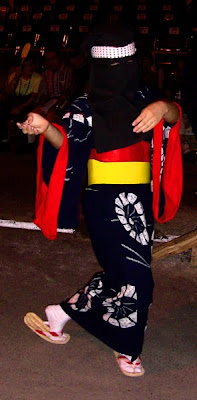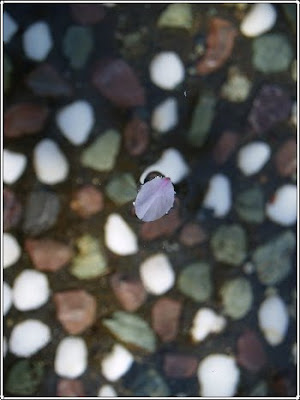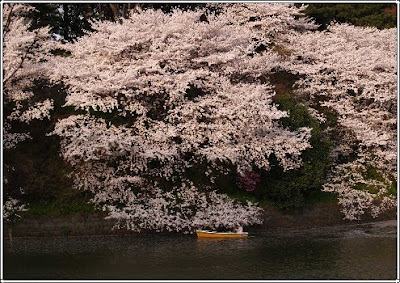Matsuri Madness - Japanese Festival Report
Japanese Festivals known as Matsuri are fun events to attend. They represent old and new Japan from old farming rituals to Buddhist ceremonies to Anime parades. Here is a collection of photographs, videos, and stories of my experiences with Japanese festivals. You can search Festivals by keywords directly or by month, region, and type. Feel free to post questions!
Thursday, March 10, 2011
Koenji Awa Odori Festival
TIME: Last Weekend of August
PLACE: Koenji, Tokyo
GETTING THERE: Chuo Line
Awa Odori is a traditional dance from the Shikoku region. Its popularity has spread throughout Japan. Koenji is the second largest Awa Odori Festival outside of Shikoku with over ten thousand dancers. They've been doing the Awa Odori for several decades and it's one Tokyo's largest summer festivals.
Click here for their website
This event coincided with a Youtube Gathering. J-vlogger Ken Tanaka organized a summer youtube gathering Aug 29th at Kichijoji Park. I got there late just as it was winding down and the mosquitos were winding up to dine on the intoxicating blood of inebriated youtubers. A group of us decided to go to the Koenji Awa Odori festival.
Nishimonai Bon Odori - Dance for the Dead
The Japanese festival of Nishimonai Bon Odori
Japanese Town Dances to Remember the Dead
Obon is the time in Japan to pay respect to ancestral spirits. Japanese will travel to their home towns in order to pray at their ancestors’ graves. It’s believed the spirits of the departed return during the 3-day holiday – mainly in mid-August. These returning spirits are not to be feared like the ones that come with Halloween. In fact, they are welcomed and many communities put on a variety of celebrations.
One of the most common features of Obon is the Bon Odori, a special dance for Obon. Bon Odori dances vary from region to region each having their own particular form.
In the small town of Nishimonai in the northern prefecture of Akita, the locals perform a Bon Odori which is a mixture of an old harvest dance and a memorial to a fallen samurai lord.
The Nishimonai Bon Odori is unique in that some of the dancers were a black hood to represents the spirits of the deceased. Other dancers wear a patchwork kimono of silk fabric known as hanui and a woven straw hat called a amigasa.
The dancers’ faces are obscured by the hoods and straw hats giving the dance a surreal ghostly-like quality.
The singers sing in the old Akita dialect which many Japanese outside of Akita have difficulty understanding.
Japanese Town Dances to Remember the Dead
Nishimonai Bon Odori – Japanese Dance for the Dead
Obon is the time in Japan to pay respect to ancestral spirits. Japanese will travel to their home towns in order to pray at their ancestors’ graves. It’s believed the spirits of the departed return during the 3-day holiday – mainly in mid-August. These returning spirits are not to be feared like the ones that come with Halloween. In fact, they are welcomed and many communities put on a variety of celebrations.
Some dancers wear a black hood to represent deceased spirits
One of the most common features of Obon is the Bon Odori, a special dance for Obon. Bon Odori dances vary from region to region each having their own particular form.
Some of the dancers wear a straw hat known as amigasa
In the small town of Nishimonai in the northern prefecture of Akita, the locals perform a Bon Odori which is a mixture of an old harvest dance and a memorial to a fallen samurai lord.
The Nishimonai Bon Odori is unique in that some of the dancers were a black hood to represents the spirits of the deceased. Other dancers wear a patchwork kimono of silk fabric known as hanui and a woven straw hat called a amigasa.
Some dancers wear hanui a patchwork kimono of silk fabric
The dancers’ faces are obscured by the hoods and straw hats giving the dance a surreal ghostly-like quality.
The singers sing in the old Akita dialect which many Japanese outside of Akita have difficulty understanding.
The Nishimonai Bon Odori takes place just after the traditional dates for Obon from August 16-18, the big day being the 18th where the dance lasts for several hours in the evening.
TIME: August 18th - evening
PLACE: Ugo city, Akita Prefecture, Tohoku
GETTING THERE: Bus or car from Yuzawa
Oktoberfest in Tokyo (Hibiya Park)
Here are some scenes from an Oktoberfest celebration in Hibiya Park in the middle of Tokyo.
Beer, saurkraut, big pretzels, sausages, and yakisoba. Plus enough cowbell to sastify even Christopher Walkens.
Main problem though is the lines! It's not like Oktoberfest where they bring your food and drink to you. You have to stand in line and sometimes really long lines so get there early.
There quite a number of Oktoberfest events throughout Japan mainly in September and October. Be sure to check local listings!
TIME: mid-Sept around the 15th-17th from Weds-Friday. Evenings 5:00-10:30
PLACE: Hibiya Park, Tokyo
GETTING THERE: 2 mins from Hibiya Stn on Hibiya Line or 8 mins from Yurakucho on JR Line
Video Clips of the Kamogawa Odori Geisha Dance
Video Clips of the Kamogawa Odori Geisha Dance
Here a character in "A Portrait of the Snow Lady on a Fan," called Akane, the fiance of the Fan Maker, dances.
This is a scene from the story: "A Portrait of the Snow Lady on a Fan."
Story involves Yuki-Onna, the snow woman, and a handsome fan maker she loves. He refuses her love because he loves another and so she freezes him
The Fan Maker is rescued by his fiance and they return to Kyoto as Spring begins.
Maiko (apprentice geisha) dance to represent Spring at Dawn the favorite time for Sei Shonagon:
"In spring it is the dawn that is most beautiful. As the light creeps over the hills their outlines are dyed a faint red and wisps of purplish cloud trail over them."
Two Geisha dance to represent Autumn Evenings from Sei Shonagon's Pillow Book:
"In autumn the evenings ... when the sun sets, one's heart is moved by the sound of the wind and the hum of the insects."
Geisha apprentice, Maiko, dance and throw treats to the audience at the Kamogawa Odori Geisha Performance in Kyoto.
Wednesday, March 9, 2011
Japanese Night Festival: Chichibu Yo Matsuri
Chichibu Night Festival Lights Up the Sky
Gigantic floats, chanting pullers and spectacular fireworks draw thousands of revelers
TIME: Dec 2&3 12pm-8pm (the 2nd) &1pm-10pm (3rd)
PLACE: Chichibu, Saitama Prefecture (north of Tokyo)
GETTING THERE: SEIBU Line from Ikebukuro (1hr 20mins)
The Chichibu Yo-Matsuri (Night Festival), dating back to the 18th century, is one of the three most famous night festivals in Japan. The small city of Chichibu lies two hours northwest of Tokyo in the mountainous regions of Chichibu National Park. Despite the cold, large crowds descend upon the city every year in early December to see the colorful, illuminated floats parade through the streets.
Six massive decorative floats festooned with a myriad of lanterns are pulled through the streets by large teams of men and women in festival attire. The floats weigh nearly ten tons and some of them are over 30-feet high. These floats require teams of nearly a hundred people pulling and pushing to get them moving. In front of the floats two long lines of people pull on large ropes while chanting "Wa-shoi! Wa-shoi!" (which is like saying "Heave, ho!"). Between them, walked colorfully-attired men rhythmically clacking wooden blocks together.
On the floats themselves, groups of singers waving handheld lanterns chant and shout as they pass by. On each float a taiko drum is beaten furiously, accompanied by wildly shrilling flutes. On top of the float, sometimes a man stands waving a folding fan to the rhythm of the taiko drum and flutes.
Occasionally, the parade hits a bit of a snag much to the relief of the rope pullers and float pushers, no doubt. Some of the rope pullers tried to bamboozle yours truly into pulling their seven-ton float, but I sheepishly declined, claiming an allergic reaction to physical labor.
The floats eventually come to a small, but steep hill where pullers and pushers have to gather up a surge of energy to yank their heavy float to the top of the hill, which also marks the end of the parade.
South of the parade, fireworks light up the cold night sky. Below, dozens of temporary food stalls serve up piping hot food and drink to the thousands of visitors.
The Chichibu Yo-Matsuri is definitely a festival to experience. However, festival-goers should be wary of the earliness of the last trains back to Tokyo. The last trains back end around 10:30. This I did not know. When I took a train at 10:40, I reached a station that was still a good ways out of Tokyo and remained there until the next morning. I ended having to take refuge from the cold in an all-night "Manga-kissa" -- Internet/comic book cafe.
Gigantic floats, chanting pullers and spectacular fireworks draw thousands of revelers
 |
| A decorative float burdened with singers makes it way down the streets of Chichibu, two hours northwest of Tokyo. |
TIME: Dec 2&3 12pm-8pm (the 2nd) &1pm-10pm (3rd)
PLACE: Chichibu, Saitama Prefecture (north of Tokyo)
GETTING THERE: SEIBU Line from Ikebukuro (1hr 20mins)
The Chichibu Yo-Matsuri (Night Festival), dating back to the 18th century, is one of the three most famous night festivals in Japan. The small city of Chichibu lies two hours northwest of Tokyo in the mountainous regions of Chichibu National Park. Despite the cold, large crowds descend upon the city every year in early December to see the colorful, illuminated floats parade through the streets.
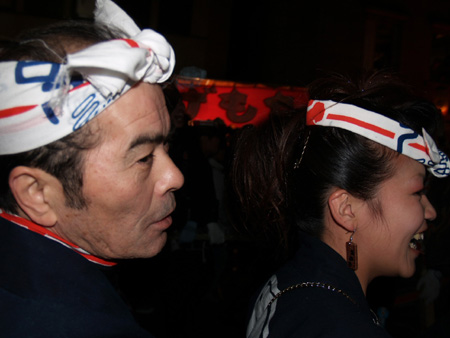 |
Festival participants |
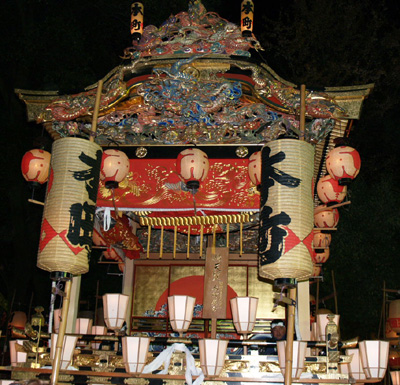 |
An empty float before the parade |
 |
A fishy decorated float |
The floats eventually come to a small, but steep hill where pullers and pushers have to gather up a surge of energy to yank their heavy float to the top of the hill, which also marks the end of the parade.
 |
A singer aboard a float sings out into the cold night |
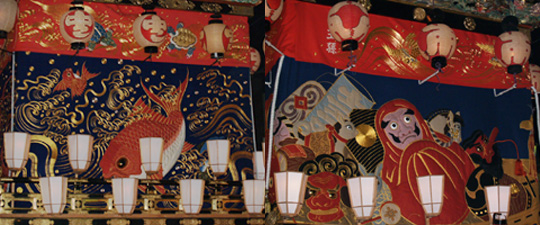 |
The backsides of two colorful floats |
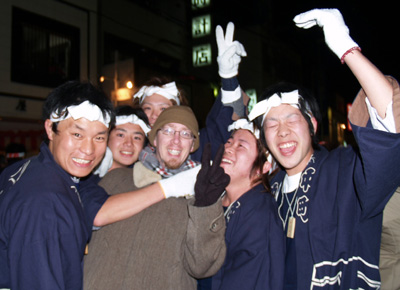 |
Shanghaied! |
 |
Fireworks explode over a busy street |
 |
"Wa-shoi! Wa-shoi!" |
 |
Three red-headed maidens decorate the back of one float |
Youtube Hanami Gathering - Japanese Cherry Blossom Viewing Party
YOUTUBE HANAMI GATHERINGS
When the Cherry Blossoms bloom, blue tarps go down and beer cans go up in toast as hanami revelers party under the pink sakura. Hanami is a tradition that goes back over a thousand years and J-vloggers on Youtube have proudly picked up this tradition.
J-vlogger TokyoCooney organized the first Youtube Hanami gathering in 2008 and has continued to do so.
Tokyo Youtube Gathering: Pre-gathering Hanami in Ueno Park
This video is a prelude to the 2008 Youtube Hanami Gathering. A few J-vloggers gathered together in the evening in Ueno Park a popular spot for Hanami and had a few drinks.
2008 Youtube Hanami Gathering 2nd Half at Hub Pub
Unfortunately due to work I missed the first part of the 2008 Hanami in Yoyogi Park but I caught the end of it at the Hub Pub in Shibuya.
Youtube Tokyo Hanami Party 2009
The 2nd Annual Tokyo Youtube Hanami Party was held Sunday March 29th in Yoyogi Park.
Quite a number of people showed up. Familiar faces, new faces, and people just passing by. We had KFC, Krispy Kreme, ramen, beer, and Chu-Hi.
One major lesson to learn here is that you DO NOT wear your shoes on the blue tarp. Japanese remove their shoes before getting on their hanami blue tarp so as not to get the tarp or their clothes dirty.
Cherry Blossoms, Samurai, Beer, Girls, Cleavage - Tokyo Youtube Hanami 2010
The 3rd Annual Tokyo Youtube Hanami was held in Yoyogi Park on March 27th. Many Youtubers and Youtuber fans were in attendance.
Hanami is the Japanese tradition of cherry blossom viewing which basically means viewing them from a blue tarp getting completely smashed. We Youtubers took to this tradition like a duck to vodka. A drunk Elevencolors made himself immensely amusing. No Youtube Hanami would be complete without one!
When the Cherry Blossoms bloom, blue tarps go down and beer cans go up in toast as hanami revelers party under the pink sakura. Hanami is a tradition that goes back over a thousand years and J-vloggers on Youtube have proudly picked up this tradition.
J-vlogger TokyoCooney organized the first Youtube Hanami gathering in 2008 and has continued to do so.
Tokyo Youtube Gathering: Pre-gathering Hanami in Ueno Park
This video is a prelude to the 2008 Youtube Hanami Gathering. A few J-vloggers gathered together in the evening in Ueno Park a popular spot for Hanami and had a few drinks.
2008 Youtube Hanami Gathering 2nd Half at Hub Pub
Unfortunately due to work I missed the first part of the 2008 Hanami in Yoyogi Park but I caught the end of it at the Hub Pub in Shibuya.
Youtube Tokyo Hanami Party 2009
The 2nd Annual Tokyo Youtube Hanami Party was held Sunday March 29th in Yoyogi Park.
Quite a number of people showed up. Familiar faces, new faces, and people just passing by. We had KFC, Krispy Kreme, ramen, beer, and Chu-Hi.
One major lesson to learn here is that you DO NOT wear your shoes on the blue tarp. Japanese remove their shoes before getting on their hanami blue tarp so as not to get the tarp or their clothes dirty.
Cherry Blossoms, Samurai, Beer, Girls, Cleavage - Tokyo Youtube Hanami 2010
The 3rd Annual Tokyo Youtube Hanami was held in Yoyogi Park on March 27th. Many Youtubers and Youtuber fans were in attendance.
Hanami is the Japanese tradition of cherry blossom viewing which basically means viewing them from a blue tarp getting completely smashed. We Youtubers took to this tradition like a duck to vodka. A drunk Elevencolors made himself immensely amusing. No Youtube Hanami would be complete without one!
Sakura - Japanese Cherry Blossoms
The Short, Happy Life of the Cherry Blossom
Shikishima no
Yamato-gokoro wo
Hito-towaba,
Asahi ni niou
Yamazakura bana.
(If one should ask you concerning the heart of a true Japanese, point to the wild cherry flower glowing in the sun.)
-- Norinaga Motoori (1730-1801)
Cherry blossoms, called sakura in Japanese, are taken very seriously in Japan. Any tourist or long-term visitor can easily notice this whatever time of the year they arrive. Sakura can be seen everywhere -- art, tea cups, TV commercials, wrapping paper, and so on.
The Great Buddha of Kamakura with cherry blossoms
The official flower of the Japanese imperial family is the stately (and hard-to-pronounce) chrysanthemum. The unofficial national flower is the cherry blossom. Of all the flowers and blossoms in Japan only the cherry blossom can bring the country to a halt: Japanese drop whatever they are doing to rush and grab a blue tarp mat so they can sit under the blossoms.
Every spring, the Japanese wait eagerly with an anticipation that borders on mania for the first blooming of the cherry blossoms. They have been doing this for well over a thousand years.
Enjoying a cherry blossom "snowfall"
Flowers and blossoms are revered to such a degree in Japan that blooming times are duly noted on calendars and Japanese often plan their vacations around them.
The blooming of the cherry blossom is the most important and the most widely celebrated. In spring, cherry trees barren from winter's cold grip suddenly burst forth into color and transform the landscape into a fairy tale-like wonder world.
Ogaki Castle defended by a row of cherry trees.
Even bleak urban centers become almost welcoming under a canopy of pink and white and sometimes yellow blossoms. Cherry blossoms accentuate traditional places such as shrines, temples and castles to their fullest glory. Samurai warlords often went to great lengths to beautify their castles, built for defense, with gardens, fish ponds, and cherry trees.
A lone blossom petal floats upon the water of a shrine's purification basin.
The samurai warriors of Old Japan came to take the cherry blossom as their spiritual motif. They saw in the beautiful but brief life of the sakura their own fate. The sakura falls at the height of its beauty rather than withering away. This "death" is much in the same way the samurai wished to die: In the war-torn period of Japan many samurai, like the blossoms, fell at the height of their youth and glory long before reaching old age.
Enjoying the blossoms with just a few thousand others.
Nighttime finds the Japanese gathered under the blossoms to drink, eat, and be merry as they have done for generations. Hanami (cherry blossom viewing parties) is a tradition that goes back to at least the Nara Period (710-784). Hanami was originally an aspect of Chinese influence, but it was the early-blooming plum blossoms that were honored. In the following period known as the Heien (794-1185), the cherry blossom won the attention of the Japanese and the word hanami came to be associated with cherry blossoms.
At first hanami was mainly the pastime of aristocrats but over time the practice spread to people of all walks of life. Hanami celebrants of the past enjoyed poetry games in which contestants tried to come up with new stanzas to continue a poem. Nowadays, for better or worse, portable karoake machines tend to take the place of poetry.
Food stalls selling all manner of Japanese cuisine are a common feature wherever the cherry blossoms are the thickest. Popular food items are okonomiyaki, a Japanese-type pancake of seafood and noodles, takoyaki, breaded balls containing octopus tentacle, yaki-tori, skewered chicken strips, and of course sushi.
An old cherry tree in Kyoto
The blooming season is brief -- too brief for the masses of overworked office workers. The peak period is a time for fleeing the shackles of the office.
Popular cherry blossom viewing spots are crammed with people, food vendors, and blue mats. Inebriated viewers often have a difficult time navigating themselves back to their party through a sea of hanami participants. Companies will book places in advance for their staff parties and send out rookie employees to guard the mats and alcohol during the day.
Clouds of cherry blossoms! / Is that temple bell in Ueno or Asakusa? -- Basho (17th Century)
With the arrival of Western visitors en masse to Japan in the late 19th century following the end of over two centuries of isolation, the Japanese mania for cherry blossoms every spring was viewed with some wry amusement. Certain visitors, who were more practical and with a mind for productivity, just could not see the attraction to trees that, while beautiful, did not bear fruit that could be eaten or sold. The cherry blossom was called by one such visitor as an aristocrat among flowers: not working but wanting to be admired for its beauty.
Boating under the cherry blossoms at Chidorigafuchi, Tokyo.
This view has changed and nowadays visitors together with the Japanese rush around to see the cherry blossom anywhere it blooms and admire its brief but beautiful life.
If there were no cherry blossoms in this world / How much more tranquil our hearts would be in spring. -- Ariwara no Narihira (10th Century)
TIME: Blooming varies but for much of Japan sakura blooms late March through early April. In Tohoku a popular spot is Hirosaki Castle which blooms in late April to early May
NOTE: There is no official "Cherry Blossom Festival" despite a number of people there is. Events (if any) vary from region to region. Most people just do hanami - sitting under the blossoms while eating and drinking.
Subscribe to:
Posts (Atom)




